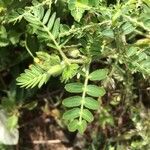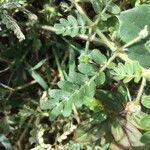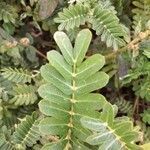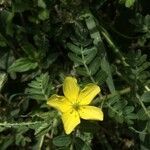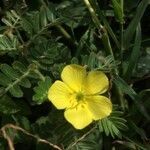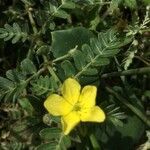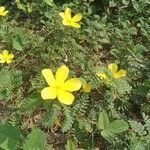Prostrate, initially villous herb; stems to 100 cm long. Leaves in unequal pairs or alternate, with 5–7 pairs of leaflets; petiole 5–20 mm long; leaflets subsessile, elliptic, 9–12 mm long, 3–5 mm wide, obliquely rounded at base, shortly acuminate, villous adaxially, particularly on midrib, denser abaxially, discolorous. Flowering pedicel 10–30 mm long, upright. Sepals 8–10 mm long, glabrous adaxially except for pubescent apex, densely villous abaxially except on hyaline margin. Intrastaminal glands 5. Petals broadly obovate, 15–16 mm long. Stamens 10, all fertile; filaments 4 mm long. Ovary densely white-strigose; style and stigma 2–3.8 mm long in flower; stigma 0.3–1.5 mm long, much shorter than style. Fruit to 8 mm high and 15 mm wide, of (2–) 3–5 tardily dissociating cocci; fruiting pedicel 23–42 mm long. Cocci woody, very sparsely strigose dorsally and with 2 longer medial spines, 2 shorter basal spines and shorter tubercles between.
Perennial herb, branches decumbent, apex ascendent, 30-14 long; tap-root very long. Leaves of each pair: one 6-7-the other 4-5-jugate, 2-7½ cm long, midrib ending into a small mucro ½-2 mm long. Leaflets subsessile, base obliquely rounded-cordate, apex blunt to subacute, 6-22 by 2½-9 mm, both surfaces silky. Stipules falcate, acucuminate, erect, 3-6 mm long. Flowers inserted laterally of the axil of the smallest leaves, bright yellow, 2½-4 cm diam.; pedicels hairy, 2-4 cm. Sepals narrow-lanceolate, acute, appressed-hairy, 7-11 mm long, caducous. Petals obovate-cuneate, apex broadly rounded-truncate, 1-2 by 1-1½ cm. Stamens subequal; anthers ± 1 mm long. Disk represented by 5 small erect scales appressed to the hirsute ovary, alternating with its lobes. Cocci 4-5 with sharp stout spines, two lateral largest; pericarp rather thick, corky.
Annual or rarely biennial yellow-green, glabrescent herb; branches mostly procumbent or erect, up to 90 cm. long; internodes 3-9 cm. long and 2.5-4 mm. in diameter.. Leaves 3-7 cm. long; leaflets 4-7 pairs, oblong, 15 × 5 mm.; stipules ovate-lanceolate, 3-6 × 2 mm.. Flower medium-sized, up to 20 mm. across; pedicel 15-30 mm., usually shorter than the subtending leaf.. Sepals lanceolate, 8 × 2 mm., deciduous.. Petals bright yellow, 8-10 × 4-5 mm.. Stamens 8-10 mm. in 2 whorls; filaments 3-5 mm. long; anthers 1 mm. long.. Ovary 1-2 mm. in diameter; style conspicuous, elongated cylindrical, 2-4 mm. long; stigma hemispherical, sometimes asymmetric.. Fruit disc-shaped; stalk 2-3 cm. long; mericarps glabrous, 8× 4 mm., provided with 2 lateral spines 5-10 mm. long and 2 basal spines 2 mm. long.
A herb. It keeps growing from year to year. The branches which lie down. They can be 1 m long. The plant has a strong taproot. The stems are hairy. The leaves are produced opposite one another. They are divided along the stalk into 6-8 pairs of leaflets. The leaf and leaflets on one side of the stalk are smaller than on the other side. The leaflets are 9-14 mm long by 3-5 mm wide. The flowers are single and 25-35 mm across. They are on stalks about 2 cm long. These flowers are produced from one axil of each pair of leaves. The flower has 5 bright yellow petals. The fruit is a round capsule which has 5 parts. These have strong sharp spines.
Herbs, perennial, prostrate to ascending. Stems 30-60 cm, densely pubescent; old branches with nodes, furrowed. Stipules opposite, 2.5-4.5 cm. Leaves with 8-14 leaflets; petiole very short; leaflet blades oblong to obovate-oblong, 6-15 × 3-6 mm, abaxially pilose, adaxially villous, base oblique, apex obtuse to acute. Flower ca. 3 cm in diam. Pedicel equal to or longer than leaves. Sepals lanceolate, ca. 8 mm, villous. Petals obovate-oblong, ca. 2 cm. Ovary yellowish hispid. Schizocarp 0.8-1.2 cm, with 4 spines or murications. Fl. May-Jun. 2n = 12, 24, 36.
Leaves unequal; the larger up to 10 cm. long with up to 9 pairs of leaflets, the smaller up to 6 cm. long with up to 5 pairs of leaflets; leaflets 4–15 (18) × 2–7 (9) mm., obliquely oblong to obovate-oblong, rarely elliptic, usually obtuse and mucronulate but also sometimes ± acute, ± densely silky-pubescent beneath, pubescent or glabrous on the upper surface.
Style usually elongate, cylindrical, up to 4 mm. long with a rather short hemispheric slightly asymmetric stigma (rarely stigma pyramidal, but then on top of the elongated style).
Perennial or rarely annual diffusely procumbent herb; stems pubescent with spreading or appressed hairs or glabrescent, multistriate.
Filaments 3–5 (7) mm. long; anthers (1) 1·2–3 mm. long, oblong or ovate-oblong.
Sepals 5–12 mm. long, lanceolate, acute, densely pubescent outside, caducous.
Stipules 5–8 mm. long, subulate, at length deciduous.
Petals yellow, up to 2 × 1–2 cm., broadly cuneate.
Peduncle much longer than the subtending leaf.
Ovary and fruit as in T. zeyheri.
